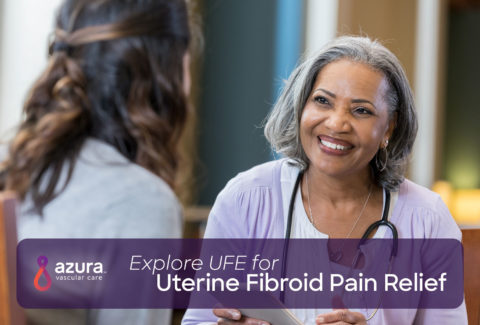
If you have uterine fibroids that are causing pain or heavy bleeding, you are probably considering your treatment options. One of those options is uterine fibroid embolization (UFE), a safe and effective, minimally invasive treatment option. UFE is performed by an interventional radiologist.
What is an Interventional Radiologist?
An interventional radiologist is a medical doctor trained to use x-rays and other imaging technology to diagnose and treat diseases using minimally invasive, targeted procedures. On average, it takes about 7 years of training after medical school to become an interventional radiologist.[i] Interventional radiologists must also pass an additional series of examinations to become board-certified.
Interventional Radiology is a sub-specialty of radiology. Many interventional radiology procedures result in less pain, a shorter recovery time, and have fewer risks than traditional open surgeries, offering safe and effective alternatives to surgery for the treatment of certain diseases.
Interventional radiologists have been using embolization to treat tumors and abnormal blood vessel formation since the mid-1960s.[ii] Uterine fibroids have been treated with embolization since 1995.[iii] Because interventional radiologists are experts in the use of x-ray to guide, place and maneuver catheters within blood vessels, they are well qualified to perform UFE. Many interventional radiologists work in state-of-the-art outpatient centers as well as in hospitals.
RELATED: 7 Things To Consider When Choosing an Interventional Radiologist
The UFE Procedure
When performing UFE, a small nick is made in the skin of the groin or the wrist and a catheter is placed through that skin nick into the femoral or radial artery. Using x-rays and contrast dye, an interventional radiologist will locate the blood vessels that are supplying the fibroids and place small beads inside of these blood vessels to block the blood flow. This deprives the fibroids of nutrients and oxygen, causing them to shrink over time.[iv] All of the fibroids can be treated in this one procedure and, when it is over, only a small bandage is required on the groin or wrist.
UFE – A Minimally Invasive Alternative to Surgery
UFE is a different, less invasive approach to the treatment of uterine fibroids. There are conventional surgeries for fibroids such as hysterectomy, which involves removing the uterus along with the fibroids. Myomectomy, another surgery to treat uterine fibroids, involves cutting into the tissue of the uterus to remove one fibroid at a time. Gynecologists are well trained in the surgical treatment of uterine fibroids, but are not trained in how to treat them through the blood vessels. Interventional radiologists often work with gynecologists to determine if a patient would benefit from UFE.
Other Interventional Radiology Procedures
Some other procedures performed by interventional radiologists to diagnose and treat diseases using catheters inside of blood vessels include:
- Angiography –Angiography involves using x-rays and an injectable dye that shows up clearly on x-ray and is used to examine blood vessels for abnormalities.
- Balloon Angioplasty –Balloon angioplasty opens up narrowed or blocked blood vessels, sometimes followed by stent placement, in the arms and legs.
- Embolization – The embolization technique is similar to UFE used to block blood flow to an area of the body and can also be used to control bleeding in a non-invasive way.
- Thrombolysis –Thrombolysis is the administration of medication to break up clots and can be used in the treatment of strokes or blood clots in the legs.
Knowing more about the type of doctor who performs UFE procedures may help you prepare for a discussion about this option. If you think UFE may be a good option to treat your uterine fibroids, or you would like to learn more about the procedure and who makes a good candidate, you should make an appointment to review your medical history and treatment goals with an interventional radiologist.
Sources:
i The American Board of Radiology. Radiology Specialties and Subspecialists. http://www.theabr.org/abr-radiology-specialties-and-subspecialties
ii Johns Hopkins Medicine. Milestones Pioneered by Interventional Radiologists. http://www.hopkinsmedicine.org/vascular/mMilestones.html
iii Society of Interventional Radiology. Uterine fibroids symptoms, diagnosis and treatment. http://www.sirweb.org/patients/uterine-fibroids/
iv Torre, A., et al., Uterine artery embolization for severe symptomatic fibroids: effects on fertility and symptoms. Hum Reprod, 2014. 29(3): p. 490-501.


